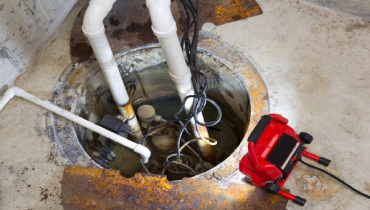
There’s nothing like stepping into a puddle on your basement floor to remind you of just how necessary sump pumps are. If you find yourself with a basement or lower level that’s regularly waterlogged, it might be time to consider a sump pump. Your neighbourhood Mr. Rooter Plumbing can help you with every step of the process.
What Does a Sump Pump Do?
Essentially, a sump pump removes water from one area and pumps it to another, usually to a spot outside of your home. They’re common (and sometimes required) and are useful for homes in low-lying or very wet areas. There are two general types of sump pumps, and the one you choose will depend on the conditions in your home.
- Pedestal sump pumps are mounted above floor level, usually on some type of pillar or pedestal.
- Submersible sump pumps, which are installed in a sump basin, are totally hidden from view. This is the more common type of sump pump.
Basically, water that collects either around your foundation walls or on the floor of the lower level of your home needs to be pumped away, and that’s what a sump pump does. The pump is triggered by a float, similar to the one in your toilet tank. When the water level reaches a certain height, it lifts the float, and the pump kicks on automatically to start removing water from the area.
Related Topic: How to Thaw a Frozen Sump Pump Line
What to Do with Sump Pump Discharge
The water that the pump removes from your home has to go somewhere, and there are a few solutions for what to do with sump pump discharge:
- Run the discharge pipe into a rain barrel. This will allow you to use the discharge water to irrigate your lawn or garden.
- Construct a dry well and run the sump pump discharge pipe into it. This well should be constructed at least ten feet from your home. The water that’s pumped into the dry well will eventually disperse into the surrounding soil.
- Connect a drainpipe and run it downhill from your home to a lower area of your property, such as a drainage ditch.
Can I Run My Sump Pump into My Septic Tank?
Your sump pump should never drain into a septic tank. That much water will overburden the system, which can result in backups, excess water in the leach field, and upsetting the balance of bacteria in the system. That balance is vital in ensuring that solid waste gets broken down efficiently.
Do All Homes Have a Sump Pump?
Not all homes have a sump pump. Sump pumps are usually found in homes with a basement or another below-ground floor. So if a home is on a slab, it generally wouldn’t need a sump pump. This is also true if a home is located at a high altitude or in an arid climate.
Find Sump Pump Technicians Near You
Sump pumps are an essential part of keeping your home comfortable, sanitary, and in good condition. A faulty sump pump can lead to a hazardous condition and can structural damage to your home and property. If you need help installing a sump pump, repairing a malfunctioning unit, or upgrading to a new one, call your local Mr. Rooter Plumbing or request an estimate online today.